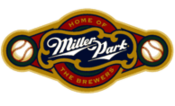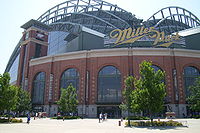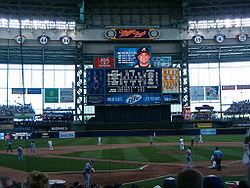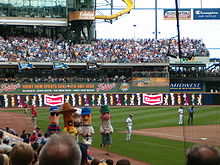- Miller Park (Milwaukee)
-
Miller Park
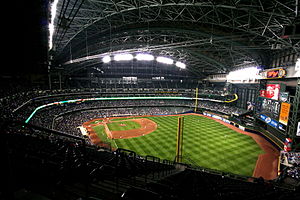
Miller Park in 2009 with the roof closed.Location One Brewers Way
Milwaukee, Wisconsin 53214Coordinates 43°1′42″N 87°58′16″W / 43.02833°N 87.97111°WCoordinates: 43°1′42″N 87°58′16″W / 43.02833°N 87.97111°W Broke ground November 9, 1996 Built 1996-2001 Opened April 6, 2001 Owner Southeast Wisconsin Professional Baseball District, Milwaukee Brewers Operator Milwaukee Brewers Surface Grass Construction cost $400 million
($496 million in 2011 dollars[1])Architect HKS, Inc.
NBBJ
Eppstein Uhen ArchitectsProject Manager International Facilities Group, LLC.[2] Structural engineer Arup, Flad Structural Engineers[3] Services engineer Arup, Kapur & Associates[3] General Contractor HCH Miller Park Joint Venture (Hunt Construction; Clark Construction; Hunsinger Co.)[4] Capacity 41,900[5] Record attendance 46,218[6] Field dimensions Left Field - 344 feet (105 m)
Left-Center - 371 feet (113 m) (Not Posted)
Center Field - 400 feet (122 m)
Right-Center - 374 feet (114 m)
Right Field - 345 feet (105 m) (Not Posted)
Backstop - 56 feet (17 m)Tenants Milwaukee Brewers (MLB) (2001–present) Miller Park is a ballpark located in Milwaukee, Wisconsin. It is home to the Milwaukee Brewers and was completed in 2001 as a replacement for Milwaukee County Stadium. The park is located just southwest of the intersection of I-94, US-41, and Miller Park Way (WIS-341). The title sponsor is the Miller Brewing Company. Miller's contract with the stadium was for $40 million, and runs until 2020.[7]
Miller park features North America's only fan-shaped convertible roof, which can open and close in less than 10 minutes. Large panes of glass allow natural grass to grow.
Contents
Construction
Miller Park is one of the largest construction projects in Wisconsin history.[8][9] It was built with $290 million of public funds from a 0.1% sales tax that began January 1, 1996, and is scheduled for retirement upon completion, sometime around 2017. The tax is applied on purchases in Milwaukee County and four surrounding counties: Ozaukee, Racine, Washington and Waukesha. The tax was controversial, in part because of the notion of using public funds for a privately owned sports team. The state senator who cast the deciding vote in the funding bill, George Petak of Racine, lost a recall election based on his vote for the stadium.[10][11]
Groundbreaking took place on November 9, 1996, in a parking lot behind County Stadium. The ballpark was originally scheduled to open in 2000. Construction was delayed after three construction workers were killed in an accident. The massive Lampson Transi-lift crane 3 (nicknamed "Big Blue"), brought in to build the roof, collapsed while lifting a 400-ton roof section, during windy conditions, on July 14, 1999. A camera crew was filming construction of the stadium on that day and captured the collapse on video as it occurred. The stadium did not open until Opening Day 2001.
The stadium has a retractable roof, built in a unique convertible style, with the roof panels opening and closing simultaneously in a sweeping manner from the first- and third-base sides toward center field. The complex and massive roof was a significant factor in the $392 million cost of the stadium. It allows the seating area to be heated 30 degrees warmer than the outside temperature when closed, allowing games to be played in inclement weather and in more comfortable conditions than an open air stadium.
The design team was appointed after a design competition in the mid 1990s. The architectural concept for the stadium was developed by the Los Angeles based sports and entertainment team NBBJ, who worked closely with a Los Angeles-based team of engineers Arup, who were responsible for all stages of the structural and building services engineering design for the stadium, with the exception of the mechanical mechanisms that move the roof structure. The original versions of these mechanisms were designed by Mitsubishi Heavy Industries America as part of a design and build contract, but they have now been replaced by new designs after their failure. The executive architect responsible for the delivery of the final stadium design was a Dallas-based team of HKS, Inc. In addition to these major players there were a significant contributions from local teams including Eppstein Uhen architects.
The stadium design followed the trend of retro-designed ballparks with current amenities that began in 1992 with Oriole Park at Camden Yards in Baltimore, Maryland.
The original grass playing surface was installed on March 10, 2001.
Structural challenges
The unconventional fan-shaped roof has not been without complications. Major elements of the pivot system behind home plate and the outfield roof track have been replaced. Even after the crane incident.[12]
At the end of the 2006 season, the roof's bogie system was replaced at a cost of over $13 million. The 10 new, 24-feet-(7.3 m)-long, 60 horsepower (45 kW) bogies were paid for with money from the settlement between the stadium district and Mitsubishi Heavy Industries of America. Six of the bogies weigh 66 tons apiece, while the four others weigh 49 tons. The work was completed by lifting sections of the roof approximately six inches with hydraulic lifts, while a 300-ton crane replaced the bogies individually. "The bogies will last for the life of the facility," said Mike Duckett, executive director of the Miller Park stadium district.[13] The project was completed by the start of the 2007 season. [14]
Additions
In time for the 2006 season there were three additions to the stadium. Two sets of LED scoreboards were added. One replaced the formerly manually-operated "out of town" scoreboards along the left and right field walls with a new set of LED scoreboards along the left-field wall. The new "out of town" scoreboards show continually updated information about other Major League games, including the score, hits, errors, outs, and an image of the field displaying the runners on base. A second-tier marquee scoreboard was also added along the bottom of the 300-level of the stadium stretching from foul pole to home plate to foul pole. The section of the second-tier scoreboard above home plate displays statistics for those unable to see the main scoreboard above the center-field wall. All of the scoreboards were designed, manufactured and installed by Daktronics, a company in Brookings, South Dakota.[15] The final addition to Miller Park for the 2006 season was the addition of a field-level picnic area in the corner of right-field. The picnic area has a capacity of 75 and provides a place for fans to watch the game in a leisurely setting and be within feet of the right-fielder. Known first as the Mercedes-Benz Field Haus, the picnic area's name was changed to AirTran Airways Landing Zone in 2009.
During the 2007 season, as the Brewers got closer to the team record of home runs in a season, a home run counter was added to the right of the center field scoreboard. In the shape of a gas pump, the counter was sponsored by Citgo, whose name could be seen as a play on words for a home run (C-It-Go). The counter kept track of the home runs hit by the Brewers during the season and when a home run was hit, the player's name was shown on the display as well as the distance of the home run. The Citgo home run counter was removed after the 2009 season.
Early into the 2008 season, the Brewers also added a sponsored strikeout counter to the tier of the second deck of the right field bleachers, which illuminates a K when a Brewers' pitcher notches a strikeout and keeps track of how many strikeouts as a team the Brewers have. Prior to this addition, Bernie Brewer would hang strikeout K's from the railing of his club house, including backwards K's to denote a called strike three.
In 2009, Miller Park's outfield was replaced with "Lo-Mo" Kentucky bluegrass just like the infield was the prior year. The new turf, common in other ballparks around baseball, is denser and has a sand base, instead of the sand and clay mix under the original grass. The turf yields truer hops and fewer instances in which the baseball skips under an outfielder's glove than the previous turf.[16] Also for the 2009 season, the Harley-Davidson Deck was opened on the field level of the stadium in left-center field.
During the off-season between 2010 and 2011, the stadium's original centerfield scoreboard (a smaller videoboard atop a larger black and amber message display board) was replaced by a full length and full color Daktronics 1080p high definition display board which is the fourth-largest screen among current MLB stadiums, along with a public address/sound system upgrade.[17]
Popularity and attendance
In 2005, Sports Illustrated conducted fan surveys that rated Miller Park the best ballpark based on value per dollar spent.[citation needed] Although attendance dropped after the 2001 opening season to a low of 20,993 per game in 2003, attendance rebounded in subsequent seasons. In 2008, the Brewers set a franchise record for attendance with over 3,000,000. This was 9th among 30 major league teams, despite Milwaukee being one of the smallest markets in baseball.[18]
An upscale lounge, the "Gehl Club", located next to the "NYCE Club," opened in 2007.
Attractions
- The Klement's Sausage Race occurs during each game in the middle of the 6th inning; it was moved from the bottom of the 6th inning to enable the sausages to create more excitement for the fans as the Brewers prepared to bat. The current "racing sausages" are the bratwurst, the Italian, the chorizo, the Polish, and the hot dog. The Chorizo sausage (to salute the region's growing Latino population) was added on July 29, 2006 for one race, and became a full-time participant in 2007.
- Bernie Brewer, the team mascot, has a club house above the left field seats. Following every Brewers home run and victory, Bernie Brewer makes a splash in the new "Kalahari Splash Zone" area, which sends an explosion of water into the air. The feature can be adjusted to send more water into the air, giving fans seated below an experience similar to attractions at the Kalahari Resorts in the Wisconsin Dells. This is different from his old home at Milwaukee County Stadium, where Bernie slid into a giant mug of beer in center field which had been sponsored over the years by Pabst, Miller, and Sentry Foods. During the home run celebration, a short burst of fireworks is shot out from the top of the center field scoreboard, and above Bernie's club house, the call words of Brewers' radio announcer Bob Uecker are illuminated, "Get Up, Get Up, Get Outta Here, Gone!"
- During the seventh inning stretch, in addition to "Take Me Out to the Ballgame", fans at Miller Park sing "Roll Out the Barrel", in salute to Milwaukee's beer-making history.
Notable events
Baseball
On opening day in April 2001, President George W. Bush and owner Bud Selig had first pitch honors for the stadium. The park hosted the 2002 MLB All-Star Game, which ended infamously in a tie. It was also a major filming location for the motion picture Mr. 3000, which centered on a fictional Brewers player.
In April 2007, snow storms in northern Ohio caused the Cleveland Indians to postpone their home opening series against the Seattle Mariners and forced the Indians to find a different location for their home series against the Los Angeles Angels of Anaheim. Major League Baseball took advantage of Miller Park's roof and moved the Indians-Angels series to Milwaukee. All seats were sold for $10 apiece, and attendance was 52,496 for the three games.[19] The series was a reminder to many of the 1989 film Major League, which featured scenes filmed in Milwaukee County Stadium, though the film was about a fictionalized Cleveland Indians team. The first game of the series was played on the same day that the film's "Wild Thing Edition" was released on DVD. When Joe Borowski came to close for the Indians, the song "Wild Thing" was played over the PA system, in an homage to the film. Also, the Indians' mascot Slider slid down Bernie Brewer's slide following Indians home runs.[20] These games were the first to be played under American League rules in Milwaukee since 1997 (the Brewers' final season in the AL), and have been the only games played under AL rules in Miller Park.
Hurricane Ike's landfall in Houston forced the Chicago Cubs and Houston Astros to play a two-game series at Miller Park on Sunday, September 14 and Monday, September 15, 2008.[21] The park became the first neutral site in Major League history to host a no-hitter, when Carlos Zambrano of the Chicago Cubs threw the first no-hitter in the history of the park against the Houston Astros on Sunday, September 14, 2008. The next day, his teammate Ted Lilly, took a no-hitter into the 7th inning.[22][23]
Bowling
Miller Park hosted the 2007 United States Bowling Congress Masters finals on Sunday, October 28, 2007. The playing surface was fitted with four bowling lanes for the tournament.[24]
Concerts
Dave Matthews, Willie Nelson, Neil Young, John Mellencamp and many others headlined Farm Aid’s 25th Anniversary concert on October 2, 2010 here, the first time the charity event was held at a major league stadium.[25]
Pro football
Miller Park is one of the venues being considered for a United Football League expansion team according to league commissioner Michael Huyghue.[26] The league currently has plans to add two expansion teams per year for the 2011 and 2012 seasons and has expressed desire to place two of those teams in the Midwest. Recent expansions and relocation in the UFL have shown a preference for media markets where the National Football League does not operate a team.
However, the Brewers maintain that Miller Park was not built with the intention of also fielding a football team, though the stadium in the early 90's was planned to have a football layout before the Packers decided to play in Green Bay full-time after the 1994 season and subsequent redesigns as a baseball-only facility.
See also
- List of baseball parks in Milwaukee
References
- ^ Consumer Price Index (estimate) 1800–2008. Federal Reserve Bank of Minneapolis. Retrieved December 7, 2010.
- ^ "Miller Park". Projects. International Facilities Group, LLC.. http://www.ifgroup.cc/content/?section=506§ion2=590§ion3=530&page=530.
- ^ a b "ARCHITECTS-CONTRACTORS-AND-SUBCONTRACTORS-OF-CURRENT-BIG-FIVE-FACILITY-PROJECTS". Sports Business Journal (Street & Smith's). doi:July 24, 2000. http://www.sportsbusinessdaily.com/Journal/Issues/2000/07/20000724/No-Topic-Name/ARCHITECTS-CONTRACTORS-AND-SUBCONTRACTORS-OF-CURRENT-BIG-FIVE-FACILITY-PROJECTS.aspx.
- ^ http://www.ballparks.com/baseball/index.htm
- ^ The Official Site of The Milwaukee Brewers: Ballpark: Facts, Figures, & Ground Rules, MLB.com.
- ^ http://www.baseball-reference.com/boxes/MIL/MIL200309060.shtml
- ^ ESPN.com: SPORTSBUSINESS - Stadium naming rights
- ^ "Facts, Figures & Rules". Milwaukee.brewers.mlb.com. MLB Advanced Media, L.P.. http://milwaukee.brewers.mlb.com/mil/ballpark/mil_ballpark_field.jsp. Retrieved 19 November 2011.
- ^ "Miller Park". Emporis.com. EMPORIS GMBH. http://www.emporis.com/building/millerpark-milwaukee-wi-usa. Retrieved 19 November 2011.
- ^ http://www2.jsonline.com/sports/brew/mpark/mar01/fan31033001.asp
- ^ http://greg-bromberg.blogs.sportsline.com/mcc/blogs/view/5814658?tag=George%20Petak
- ^ Walker, Don, "Design flaws noted in Miller Park roof", Milwaukee Journal Sentinel, April 17, 2002.
- ^ Walker, Don, "As baseball season ends, stadium roof repair begins", Milwaukee Journal Sentinel, September 21, 2006.
- ^ Walker, Don, "Miller Park roof is back at full speed", Milwaukee Journal Sentinel, July 13, 2007.
- ^ "Daktronics Photo Gallery: Miller Park". http://www.daktronics.com/ProductsServices/PhotoGallery/Pages/default.aspx.
- ^ http://mlb.mlb.com/news/article.jsp?ymd=20090414&content_id=4260030&vkey=news_mil&fext=.jsp&c_id=mil
- ^ http://www.jsonline.com/sports/brewers/97990759.html
- ^ "MLB Attendance Report - 2007", ESPN.com, October 1, 2007.
- ^ Castrovince, Anthony (2007-04-09). "Angels-Indians series moved". Cleveland: MLB.com. http://www.mlb.com/news/article.jsp?ymd=20070409&content_id=1888109. Retrieved 2009-02-15.
- ^ Drehs, Wayne (2007-04-10). "Indians feel right at home in Milwaukee". Milwaukee: ESPN.com. http://sports.espn.go.com/mlb/news/story?id=2832830. Retrieved 2009-02-15. "Even Slider, the team's mascot, got into the act, making the trip to Milwaukee so he could twist his way down Bernie Brewer's slide after Kelly Shoppach and Casey Blake hit Indians' home runs. In the top of the ninth, when Borowski came in to close out the game, the Miller Park sound system blasted "Wild Thing," a tribute to the baseball classic "Major League," which was filmed in Milwaukee."
- ^ "Cubs-Astros to play at Miller Park". Milwaukee: jsonline.com. 2008-09-14. http://www.jsonline.com/sports/brewers/32536479.html. Retrieved 2009-04-11.
- ^ "Zambrano Throws No-Hitter as Cubs Beat Astros 5-0". Milwaukee: abcnews.go.com. 2008-09-14. http://abcnews.go.com/Sports/wireStory?id=5801676. Retrieved 2009-04-11.[dead link]
- ^ "Zambrano's first no-no is also first at Miller Park". Milwaukee: jsonline.com. 2008-09-15. http://www.jsonline.com/sports/brewers/32534739.html. Retrieved 2009-04-11. "Zambrano, who pitched the first no-hitter in the history of Miller Park, smiled as he talked about how much he likes to pitch in the Brewers' stadium. "I like the mound, and it's a beautiful ballpark," Zambrano said. "I wish we had a new ballpark, a clubhouse like that.""
- ^ Milwaukee Brewers press release, "Miller Park to host 2007 USBC Masters finals", MLB.com, May 24, 2007.
- ^ JSOnline Press Release - http://www.jsonline.com/entertainment/musicandnightlife/99734759.html?page=3#comments
- ^ http://www.jsonline.com/blogs/business/57272617.html
External links
- Stadium site on brewers.com
- USGS aerial of old park and new construction
- Miller Park photos on Flickr
- Aerial view of Miller Park
Categories:- Event venues established in 2001
- Major League Baseball venues
- Milwaukee Brewers stadiums
- Retractable-roof stadiums
- Sports venues in Milwaukee, Wisconsin
- NBBJ buildings
Wikimedia Foundation. 2010.

